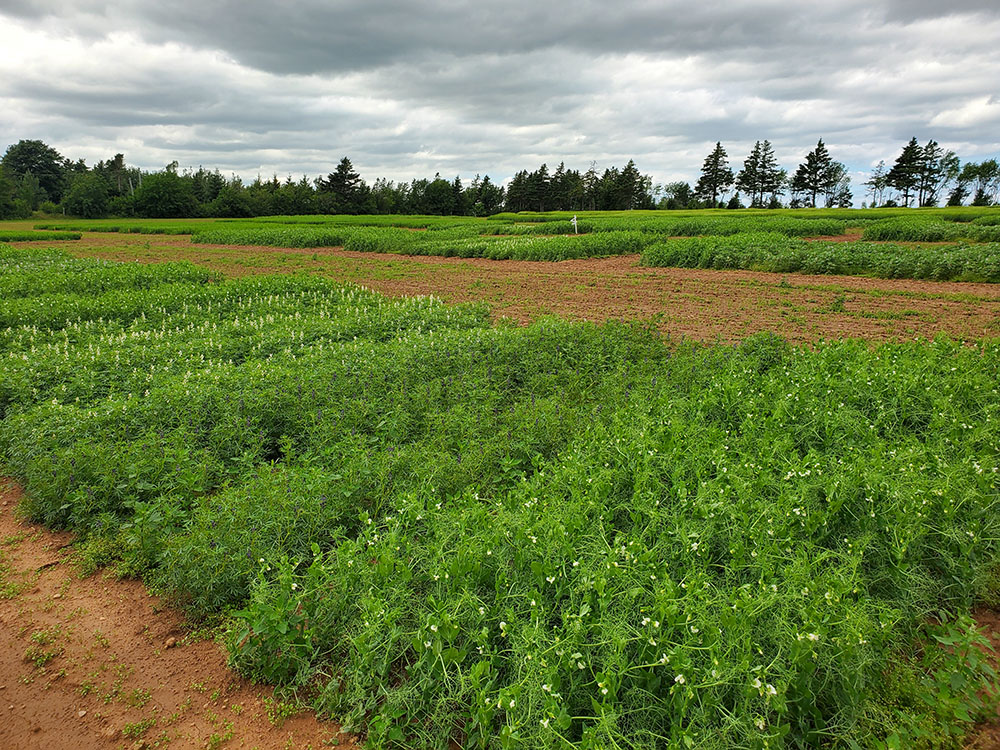Set up an interview
Media Relations
Agriculture and Agri-Food Canada
1-866-345-7972
aafc.mediarelations-relationsmedias.aac@agr.gc.ca
Driving along Canadian roads you’re likely to spot tall pink and purple coloured flowers sprawling across the landscape in fields and ditches. So much so you’d think it was Canada’s national flower. These wild flowers have a blossoming close relative – the sweet white lupin – that has the potential to provide a new source of high-quality protein and open up new markets for Canadian farmers.
Wild lupins may look pretty, but they don’t offer much else in value as they contain a high amount of a toxic substance called 'lupanine'. This substance makes them poisonous to humans and animals.
So, what is the link to lupins and agriculture? Fortunately, the sweet white lupin has more personality to go with its good looks. The sweet white lupin is an edible pulse crop, similar to peas or beans, that contains high protein and is a source of essential nutrients. Sweet white lupin is most commonly grown in Europe and could be another crop to help Canadian farmers diversify.
White lupins have numerous advantages for farmers. They tend to be high yielding and have a strong economic potential. This crop can be used as a highly nutritious feed for cattle or for human consumption. White lupins provide nitrogen into the soil, which will also help the next season’s crop to grow, reducing the need to apply fertilizer. Even more, white lupins are harvested earlier than some other crops, like soybeans, which gives farmers more time to plant a cover crop in the fall in order to protect the soil from erosion in winter and spring. White lupins even help to capture carbon from the air and reduce greenhouse gas emissions.
The potential value of white lupins to farmers and to the environment is the reason Lupin Platform Inc., an agri-business based in Calgary, Alberta, is collaborating with farmers and Agriculture and Agri-Food Canada (AAFC) scientists to develop this crop in Canada. They recently began a three-year project to research the economic benefits of white lupins for farmers and to study how the crops fare in the growing conditions of several provinces such as Prince Edward Island, Ontario, Alberta and British Columbia.
“We are extremely excited for the opportunity to continue the research trials with AAFC. Sweet white lupin has a very high protein and dietary fibre composition that makes it an exciting source of plant-based protein ingredients. It also fixes nitrogen to the soil, which reduces the need for inputs, reducing emissions, and benefiting Canadian farmers that add it to their rotation," says Tristan Choi, CEO, Lupin Platform Inc.
Among the collaborators is Dr. Aaron Mills, an AAFC agronomist in Prince Edward Island. He wants to see how well white lupins grow on the Island. Many other pulse crops have been shown to do well in Prince Edward Island. If there is a viable market, then sweet white lupins could be a good rotation crop for farmers.
“The growing conditions and soil in parts of the Maritimes fit the profile of what sweet white lupins need to thrive. A few farmers are already successfully growing it on PEI, so we want to help generate some local data to help develop this into a viable crop for the region.”
- Dr. Aaron Mills, Research Scientist, Agriculture and Agri-Food Canada
Throughout the project, Dr. Mills will be researching basic production methods, including weed control, planting density, and the suitability of different varieties of white lupins to Maritime growing conditions. The trials are taking place at the AAFC Harrington Research Farm near Charlottetown.
“As most pulses are great at capturing carbon and nitrogen from the air, sweet white lupin should help to reduce greenhouse gas emissions, and we also hope that this crop will open up some new business opportunities in countries that Canadian farmers may not have previously developed,” says Dr. Mills.
With sweet white lupins growing in popularity in Asia and Europe, the time is ripe for Canadian farmers. Toward the end of 2023, collaborators are seeking the right mix to provide farmers with the expertise they’ll need to grow and profit from sweet white lupins.
Key Discoveries/Benefits
- White lupins have numerous advantages for farmers and the environment. They potentially have a high yield and can be used as a highly nutritious feed for cattle or food for human consumption. White lupins capture carbon and nitrogen from the air, reducing the overall carbon footprint of the crop.
- With sweet white lupins growing in popularity in Asia and Europe, the time is ripe for Canadian farmers. Lupin Platform Inc., an agri-business based in Calgary, Alberta, has partnered with farmers and Agriculture and Agri-Food Canada (AAFC) scientists to develop this crop in Canada.
- Dr. Aaron Mills, an AAFC agronomist on Prince Edward Island, is among the project partners and is studying how well different varieties of white lupins grow on the Island.
Photo gallery

